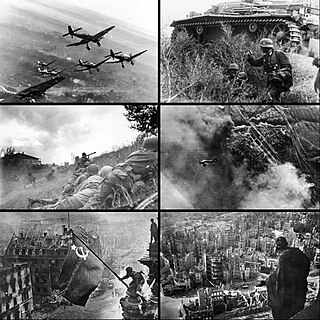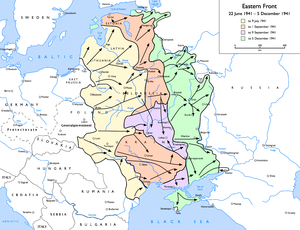
The European theatre of World War II was one of the two main theatres of combat during World War II. It saw heavy fighting across Europe for almost six years, starting with Germany's invasion of Poland on 1 September 1939 and ending with the Western Allies conquering most of Western Europe, the Soviet Union conquering most of Eastern Europe including the German capital Berlin, and Germany's unconditional surrender on 8 May 1945 although fighting continued elsewhere in Europe until 25 May. On 5 June 1945, the Berlin Declaration proclaiming the unconditional surrender of Germany to the four victorious powers was signed. The Allied powers fought the Axis powers on two major fronts, but there were other fronts varying in scale from the Italian campaign, to the Polish Campaign, as well as in a strategic bombing offensive and in the adjoining Mediterranean and Middle East theatre.

Operation Bagration was the codename for the 1944 Soviet Byelorussian strategic offensive operation, a military campaign fought between 22 June and 19 August 1944 in Soviet Byelorussia in the Eastern Front of World War II, just over two weeks after the start of Operation Overlord in the west, causing Nazi Germany to have to fight on two major fronts at the same time. The Soviet Union destroyed 28 of 34 divisions of Army Group Centre and completely shattered the German front line. It was the biggest defeat in German military history, with around 450,000 German casualties, while 300,000 other German soldiers were cut off in the Courland Pocket.
Hero City is a Soviet honorary title awarded for outstanding heroism during World War II. It was awarded to twelve cities of the Soviet Union, today located in Belarus, Russia, and Ukraine. Brest Fortress in Belarus was awarded the equivalent title of Hero Fortress. This symbolic distinction for a city corresponds to the individual distinction "Hero of the Soviet Union".

The Battle of Korsun–Cherkassy, also known as the Battle of the Korsun–Cherkassy Pocket, was a World War II battle fought from 24 January to 16 February 1944 in the course of the Soviet Dnieper–Carpathian offensive in Ukraine following the Korsun–Shevchenkovsky offensive.
The Eastern Front was a theatre of World War II which primarily involved combat between the nations and allies of Nazi Germany and the Soviet Union. Combat in the Eastern Front began with the two powers remaining peaceful towards each other, with the annexation of countries such as Albania and portions of Poland by Germany and its allies, and the annexation of Finland and the rest of Poland by the Soviet Union. However, in 1941, Nazi Germany invaded the Soviet Union, putting an end to the peacetime. The majority of major battles in the Eastern Theatre from 1941 until the end of the war in 1945 were fought between the two powers. The following timeline indicates major events taking place on the Eastern Front.

The first Battle of Smolensk was a battle during the second phase of Operation Barbarossa, the Axis invasion of the Soviet Union, in World War II. It was fought around the city of Smolensk between 10 July and 10 September 1941, about 400 km (250 mi) west of Moscow. The Ostheer had advanced 500 km (310 mi) into the USSR in the 18 days after the invasion on 22 June 1941.

Encirclement is a military term for the situation when a force or target is isolated and surrounded by enemy forces. The situation is highly dangerous for the encircled force. At the strategic level, it cannot receive supplies or reinforcements, and on the tactical level, the units in the force can be subject to an attack from several sides. Lastly, since the force cannot retreat, unless it is relieved or can break out, it must fight to the death or surrender.

Operation Little Saturn was a Red Army offensive on the Eastern Front of World War II that led to battles in Don and Chir rivers region in German-occupied Soviet Union territory in 16–30 December 1942.

The 5th SS Panzer Division Wiking or SS Division Wiking was an infantry and later an armoured division among the thirty-eight Waffen-SS divisions of Nazi Germany. During World War II, the division served on the Eastern Front. It surrendered on 9 May 1945 to the American forces in Austria.

The Battle of Narva was a World War II military campaign, lasting from 2 February to 10 August 1944, in which the German Army Detachment "Narwa" and the Soviet Leningrad Front fought for possession of the strategically important Narva Isthmus.

The 4th Panzer Army, operating as Panzer Group 4 from its formation on 15 February 1941 to 1 January 1942, was a German panzer formation during World War II. As a key armoured component of the Wehrmacht, the army took part in the crucial battles of the German-Soviet war of 1941–45, including Operation Barbarossa, the Battle of Moscow, the Battle of Stalingrad, the Battle of Kursk, and the 1943 Battle of Kiev.

The Northwestern Front was a military formation of the Red Army during the Winter War and World War II. It was operational with the 7th and 13th Armies during the Winter War. It was re-created on 22 June 1941, the first day of the Eastern Front on the basis of the Baltic Special Military District. On 22 June the Front consisted of the 8th, 11th, and 27th Armies, as well as the 5th Airborne Corps and the headquarters of the 65th Rifle Corps.

The Courland Pocket was an area of the Courland Peninsula where Army Group North of Nazi Germany and the Reichskommissariat Ostland were cut off and surrounded by the Red Army for almost a year, lasting from July 1944 until 10 May 1945.

The Heiligenbeil Pocket or Heiligenbeil Cauldron was the site of a major encirclement battle on the Eastern Front during the closing weeks of World War II, in which the Wehrmacht's 4th Army was almost entirely destroyed during the Soviet Braunsberg Offensive Operation. The pocket was located near Heiligenbeil in East Prussia in eastern Germany, and the battle, part of a broader Soviet offensive into the region of East Prussia, lasted from 26 January until 29 March 1945.

The Budapest offensive was the general attack by Soviet and Romanian armies against Hungary and their Axis allies from Nazi Germany. The offensive lasted from 29 October 1944 until the fall of Budapest on 13 February 1945. This was one of the most difficult and complicated offensives that the Soviet Army carried out in Central Europe. It resulted in a decisive victory for the USSR, as it greatly sped up the ending of World War II in Europe.
The 8th Army was a field army of the Soviet Red Army during the Second World War.

The Upper Silesian offensive was a strategically significant Soviet offensive on the Eastern Front of World War II in 1945. It was aimed at capturing the considerable industrial and natural resources located in Upper Silesia and involved forces of the 1st Ukrainian Front under Marshal Ivan Konev. Due to the importance of the region to the Germans, considerable forces were provided to Army Group Centre for its defence and the Germans were only slowly pushed back to the Czech border. Fighting for the region lasted from mid January right until the last day of the war in Europe on May 8, 1945.

During World War II, the Lapland War saw fighting between Finland and Nazi Germany – effectively from September to November 1944 – in Finland's northernmost region, Lapland. Though the Finns and the Germans had been fighting together against the Soviet Union since 1941 during the Continuation War (1941–1944), peace negotiations between the Finnish government and the Allies of World War II had been conducted intermittently during 1943–1944, but no agreement had been reached. The Moscow Armistice, signed on 19 September 1944, demanded that Finland break diplomatic ties with Germany and expel or disarm any German soldiers remaining in Finland.
The 54th Rifle Division was an infantry division of the Soviet Union's Red Army and Soviet Army, formed twice. The division was formed in 1936 and fought in the Winter War. The division spent most of World War II in Karelia fighting with Finnish troops in the Continuation War. After Finland left the war the division was relocated southward and fought in the East Prussian Offensive and the Prague Offensive in 1945. The division was disbanded in the summer of that year. The 54th Rifle Division was awarded the Order of Lenin, the Order of the Red Banner and the Order of Kutuzov 2nd class. It was also awarded the honorific "Masuria" for its actions in the East Prussian Offensive. The division was reformed in 1955 from the 341st Rifle Division and became a motor rifle division in 1957.
The 2nd Anti-Aircraft Artillery Division was an anti-aircraft artillery division of the Soviet Union's Red Army during World War II.















